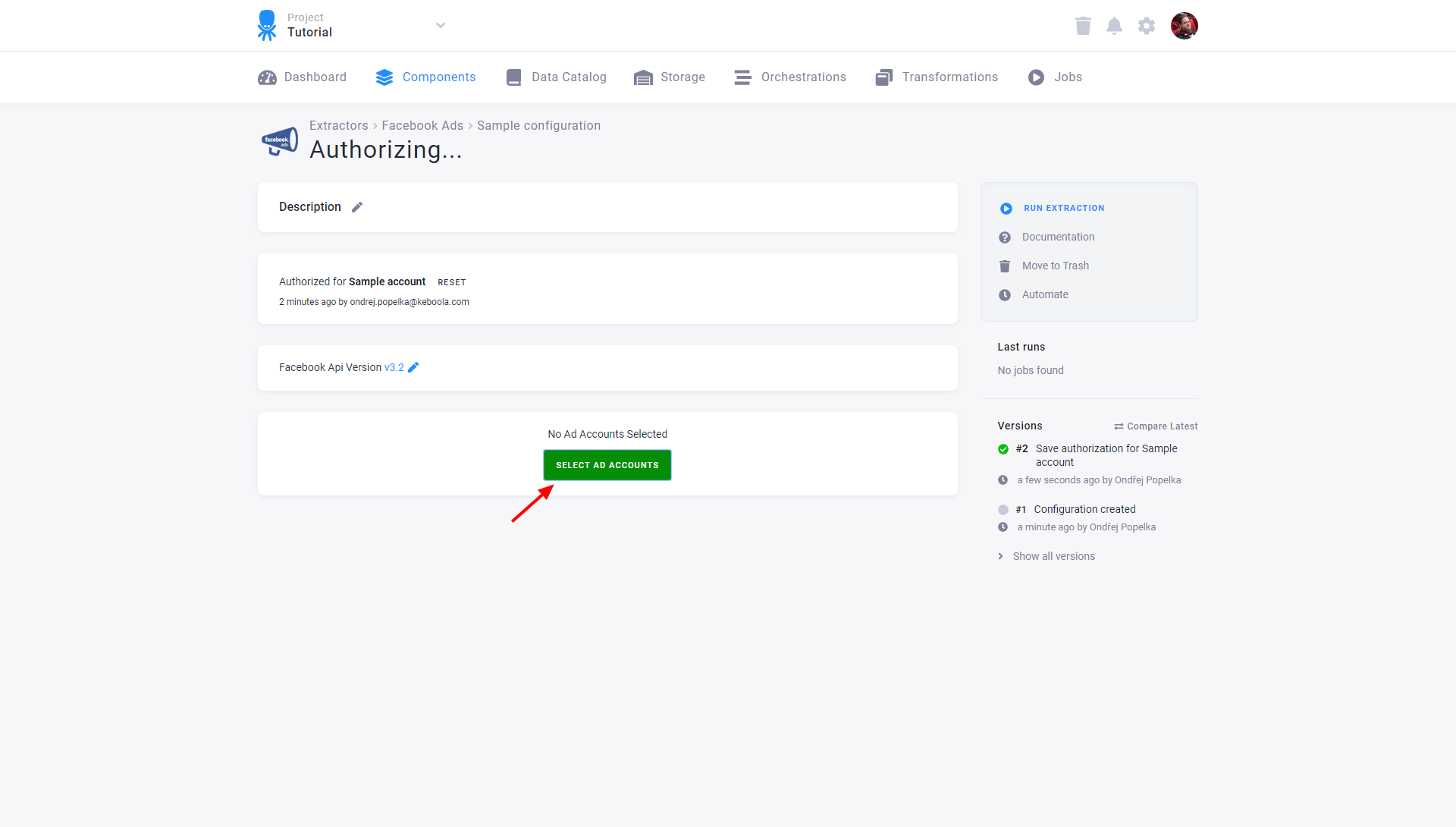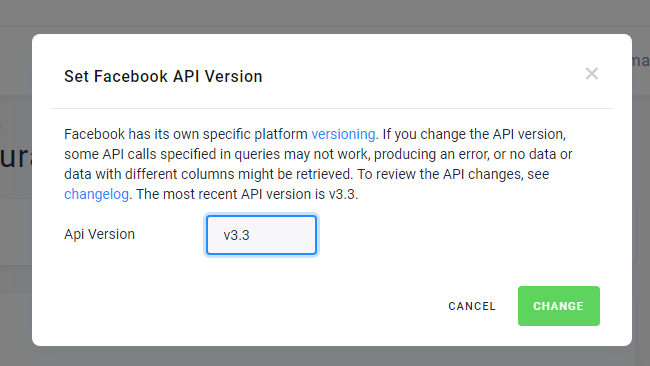Facebook Ads
This data source connector uses the Facebook Marketing API to extract Facebook Ad Account ads (including adsets, campaigns), as well as ads insights.
Configuration
Create a new configuration of the Facebook Ads connector.
Then click Authorize Account to authorize the configuration with access to the Ad Account you want to extract.
You will be asked for the public_profile,ads_management permissions.
Optionally, you can use Direct token insert to specify a manually generated access token.
You can always revoke the authorization by going to the
Facebook apps tab (under settings) and removing
Keboola Ads Data Source from the list.
Click on Select Ad accounts to load a list of Ad accounts associated with the authorization.

From the list of fetched Ad Accounts associated with the authorized account, select the Ad Accounts you wish to extract.

Create New Query
Click on the Create new query button and specify what data to extract. If you choose a preconfigured template, all necessary fields will fill in automatically.

The query describes the connector request to be sent to the Facebook Marketing API. Knowing the API will
make creating a query easy because all options except name represent the Facebook Marketing API
request parameters.
Async Insights Query
The Async Insights Query option specify the way the connector requests data. If it is checked then data will be extracted asynchronously, the connector will make an initial request, then by polling fb api waits for the result and once ready extracts it. This allows for bigger amount of data to be extracted especially when the synchronous extraction ends up with error Please reduce the amount of data you're asking for. Note that only data of the ads objects (Ad Account, Ad Campaign, Ad Set and Ad) can be extracted asynchronously.
Name
The Name option describes the query and is used to prefix all table names resulting from the query. One query can produce multiple tables. If a table name produced by the query matches the query name or its substring trimmed after the last occurrence of an underscore, then the output table name will not be prefixed and the query name will be used instead.
For example, if the query name is ads_insights and the produced table name is insights, then the
output table name will be ads_insights. If the query name is foo and the produced table name is
ads, then the output table name will be foo_ads.
Endpoint
The Endpoint option describes a significant URL part of the request made to the Facebook Marketing API.
The absolute URL is in the form https://graph.facebook.com/<api_version>/<endpoint>.
A typical example would be ads.
If left empty, the Endpoint option refers to the data of the Facebook authorized account itself.
For more information, see the list of supported Facebook Marketing API endpoints.
Fields
The Fields option describes data returned from the endpoint. Typically, it is a comma-separated list of
fields but it also can be used to parametrize the fields and nest more endpoints into it.
The ads endpoint returns all
created ads. Each ad can contain fields such as id, name and adset_id. The fields parameter in such
case is id,name,adset_id.
-
Fields/Endpoint Nesting — Ads can contain recommendations and these can be included in the fields as well:
id,name,adset_id,recommendations{title,code,message}. The comma separated list in between the curly brackets{}specifies fields of the “nested” field/endpoint ad-recommendation. This way more endpoints can be nested and there is no limit of nesting levels. -
Fields Parametrization — Each field can be parametrized by a dot followed by a modifier name and a value in brackets. A typical parameter could be
since,until,limit, or any other parameters or modifiers that the particular endpoint offers such asdate_presetfor the ads insights endpoint. The following is an example of parametrized fields:insights.action_breakdowns(action_type).date_preset(last_month).time_increment(1){ad_id,impressions,reach,actions,clicks,spend}
Parameters
The Parameters options is the only input beside name for Async Insights Query extraction. It represents parameters of ads objects of which insights will be extracted asynchronously. The parameters is in query string format, where each key=value pair is separated by an ampersand(&).
For example fields=ad_id,actions&level=ad&action_breakdowns=action_type&date_preset=last_month&time_increment=1.
Ad Accounts
This option specifies the Ad Accounts that the query will be applied to. Accounts can be chosen from a
list of selected ad accounts after authorization. The All Ad Accounts option means that the query will
be applied to all selected ad accounts; the None option says that a query will not be applied to any Ad
account. This is useful when extracting data about the authorized account itself. The Accounts option
is represented by the Facebook Marketing API parameter ids that is a comma separated list of ad account IDs.
Since and Until (Advanced tab)
The Since and Until options represent the corresponding Facebook Marketing API request parameters and
specify a date range that will be applied to time based data retrieved by the endpoint. For example,
if the endpoint is ads, then all ads created within the since-until range will be retrieved.
The Since or Until parameters are parsed via the strtotime function and can be specified
- absolutely – as a unix timestamp or in the
yyyy-mm-ddformat, or - relatively – for instance,
14 days agoorlast month.
For consistent results, specify both the since and until parameters. It is also recommended that the time range does not exceed 6 months.
Limit (Advanced Tab)
The limit option represents the Facebook Marketing API request parameter limit; it is the maximum
number of objects that may be returned on a single page of the request. (The default is 25, the maximum
is 100.) It is useful when the Facebook Marketing Api returns an error saying there is too much data
requested. In such case, lower the limit and run the query again.
Output Data Description
The output data represent a tree where each node is an array of objects returned from the Facebook Graph API. The tree is transformed into one or more CSV tables.
Each table row represents one object. Each table has the primary key auto-detected during the
extraction, so the table data is imported incrementally. The columns of the output tables represent
fields from the Fields query option. Moreover, each table will always contain the following basic set
of columns:
ex_account_id— ID of the ad account corresponding to the object stored in the row.fb_graph_node— Describes the “vertical position” of the object in the resulting tree. For example, for ads it will bepage_ads, for ads insights it will bepage_ads_insights.parent_id— Refers to theidcolumn of a parent object represented by another row and/or table. For instance, if the row is representing an insight object, its parent is an ad andparent_idis the ID of the ad. The parent object type can be also determined from thefb_graph_nodecolumn as a substring from the beginning until the last occurrence of an underscore, e.g.page_ads_insights->page_ads. The top parent ID is the ad account ID.
Ads Insights Data Description
All tables containing ads/campaigns insights data have a specific structure. Consider the following query:
- Endpoint parameter:
campaigns - Fields parameter:
insights.action_breakdowns(action_type).date_preset(last_28_days).time_increment(1){account_id,account_name,campaign_id,campaign_name,actions}
The query asks for the ads action stats data specified by the
insights api field
actions. In the api response, each insights object contains an array of actions. The resulting table
has each insights object copied into rows by the count of all such arrays, i.e., ads action stats
objects listed for each insights object in arrays. Moreover, the columns of the resulting insights table
contain the column ads_action_name with the name of the ads action array (in this case actions) and
columns from fields of ads action stats such as action_type, action_reaction and value.
Facebook API Version
You can set the version of the Facebook Marketing API that will be applied for all requests made to the API by the Facebook Ads connector. Read more about the Marketing API versions here.

